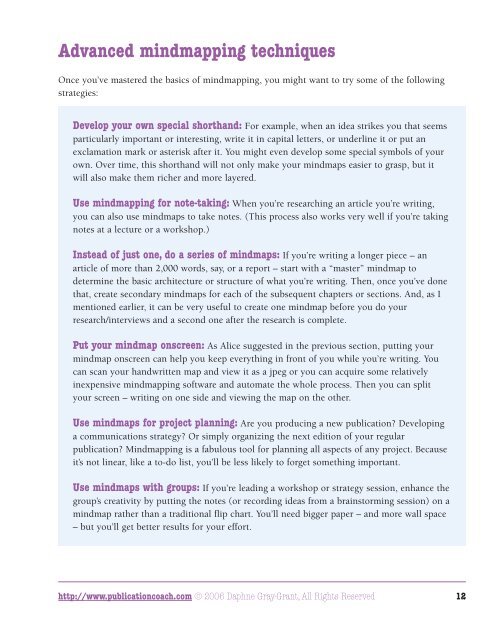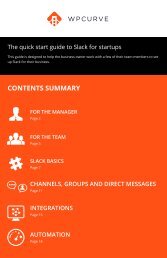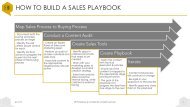Mindmapping
You also want an ePaper? Increase the reach of your titles
YUMPU automatically turns print PDFs into web optimized ePapers that Google loves.
Advanced mindmapping techniques<br />
Once you’ve mastered the basics of mindmapping, you might want to try some of the following<br />
strategies:<br />
Develop your own special shorthand: For example, when an idea strikes you that seems<br />
particularly important or interesting, write it in capital letters, or underline it or put an<br />
exclamation mark or asterisk after it. You might even develop some special symbols of your<br />
own. Over time, this shorthand will not only make your mindmaps easier to grasp, but it<br />
will also make them richer and more layered.<br />
Use mindmapping for note-taking: When you’re researching an article you’re writing,<br />
you can also use mindmaps to take notes. (This process also works very well if you’re taking<br />
notes at a lecture or a workshop.)<br />
Instead of just one, do a series of mindmaps: If you’re writing a longer piece – an<br />
article of more than 2,000 words, say, or a report – start with a “master” mindmap to<br />
determine the basic architecture or structure of what you’re writing. Then, once you’ve done<br />
that, create secondary mindmaps for each of the subsequent chapters or sections. And, as I<br />
mentioned earlier, it can be very useful to create one mindmap before you do your<br />
research/interviews and a second one after the research is complete.<br />
Put your mindmap onscreen: As Alice suggested in the previous section, putting your<br />
mindmap onscreen can help you keep everything in front of you while you’re writing. You<br />
can scan your handwritten map and view it as a jpeg or you can acquire some relatively<br />
inexpensive mindmapping software and automate the whole process. Then you can split<br />
your screen – writing on one side and viewing the map on the other.<br />
Use mindmaps for project planning: Are you producing a new publication? Developing<br />
a communications strategy? Or simply organizing the next edition of your regular<br />
publication? <strong>Mindmapping</strong> is a fabulous tool for planning all aspects of any project. Because<br />
it’s not linear, like a to-do list, you’ll be less likely to forget something important.<br />
Use mindmaps with groups: If you’re leading a workshop or strategy session, enhance the<br />
group’s creativity by putting the notes (or recording ideas from a brainstorming session) on a<br />
mindmap rather than a traditional flip chart. You’ll need bigger paper – and more wall space<br />
– but you’ll get better results for your effort.<br />
http://www.publicationcoach.com © 2006 Daphne Gray-Grant, All Rights Reserved 12
















